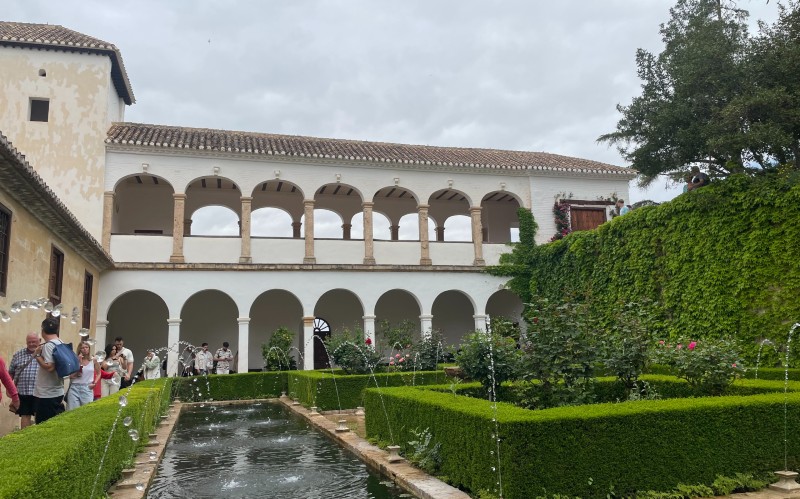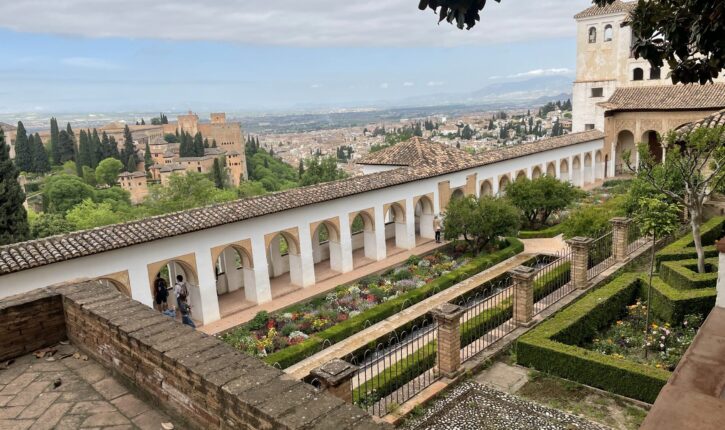Granada in Spain is a historical city with stunning architecture, and a mix of cultures. It is the culmination of the influences of the Romans and Moors which can be seen in every aspect of life.
Although short, I loved my time in Granada. the highlight was, of course, Alhambra but that aside, Granada has a number of museums, statues and monuments that will keep you occupied for a day or three. The food scene is incredible (tapas are FREE here) and all-types-of budget options for stay are available. I went for the breakfast-included option at Euro 90 a night but it was definitely great – for its food, large and comfortable rooms and proximity to the bus-stop for Alhambra.
*The following is a quick, go-to article for Granada and Alhambra.
*Nasrid Palace has a separate detailed post.
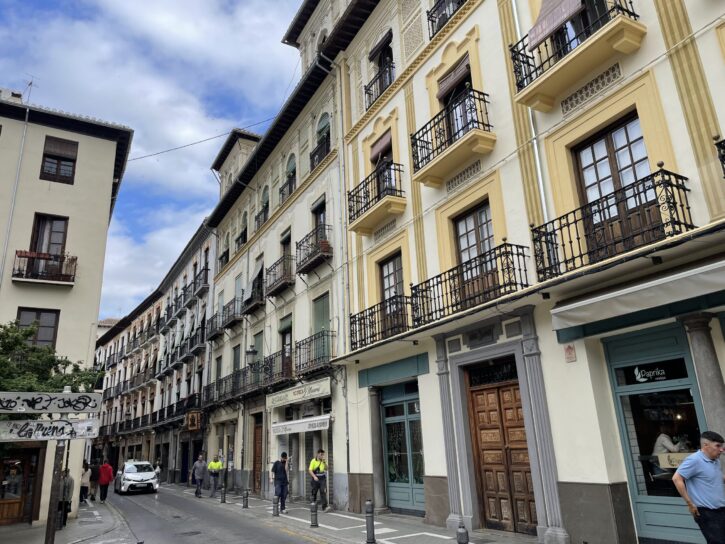
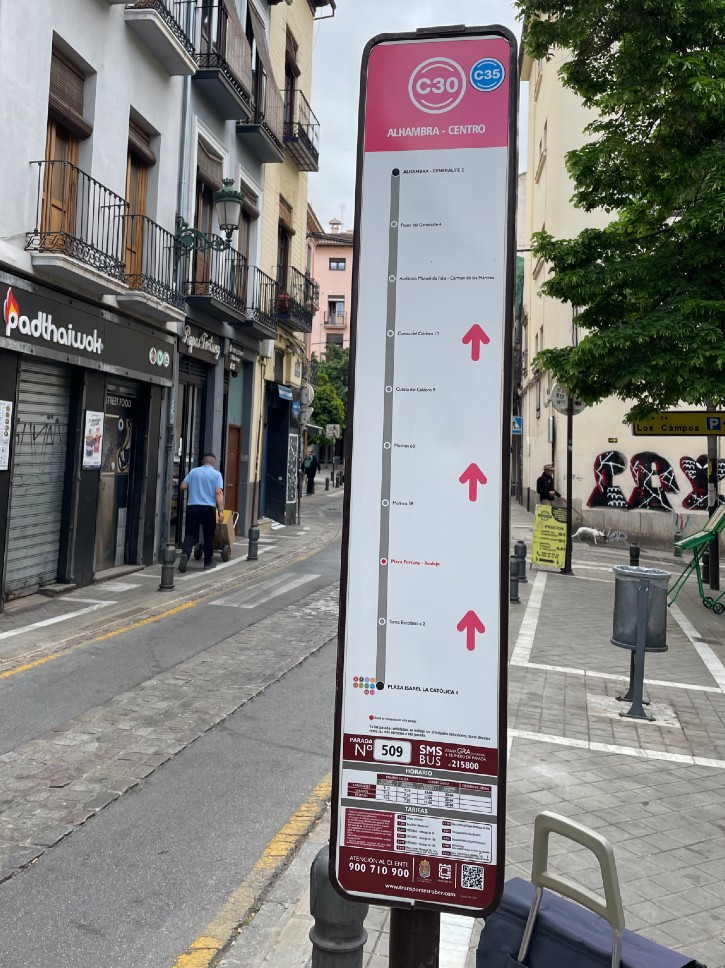
Tip: Did you know you can get a fantastic view of Alhambra from the Paseo de los Tristes (Passage of the Mourners), which follows the River Darro? The road got its name from the number of funeral processions that passed along the route on the way to burial grounds.
When here, visit the Granada Cathedral with its white-and-gold interior that reflects the historical power and wealth of the Spanish kingdom. Built in 16th century during the reign of Queen Isabella, it is considered a Spanish Renaissance masterpiece, even though it features some Gothic elements.
(Admission is 5 EUR)
Wander through the Albaicín
The Albaicín in the historic Moorish quarter of the city and, which is the oldest neighborhood of Granada. Spend some time walking through its narrow, winding streets and whitewashed buildings – somewhat like being back in the Nasrid Kingdom. Alternatively, you can see this beautiful neighbourhood from the top of Sabica Hill on your visit to Alhambra.

In the evening, hangout at Plaza Nueva, a bustling pedestrian plaza with a lot of restaurants, bars, and shops. Surrounded by classic Andalusian buildings, including the Royal Chancellery and the House of Pisa, Plaza Nueva is a great place to chill out or people-watch.
About Alhambra
There is nowhere in the world quite like Alhambra is what everyone will say. The striking Islamic architecture of the palaces, the intricate tilework and carvings, and stunning gardens will have you spellbound.
Verdict: Everything you hear about Alhambra is true.
The word Alhambra has its roots in Arabic meaning ‘the red castle’ or ‘the red one’ due to the color of the towers and walls.
My journey began with a bus ride from the Centro. I had allocated a full day for this tour – having two timed tickets: one for Alhambra and another for the Nasrid Palaces for 4pm.
Why two?
Let me answer a question that often gets asked – What are the Nasrid Palaces? Are the Nasrid Palaces the same as the Alhambra?
The two refer to different things (hence separate entry tickets) – The Alhambra refers to a fortress or citadel atop La Sabica hill. The entire complex includes the structures in the Alcazaba region, Generalife and The Nasrid Palaces which were the residences of the Nasrid royal family. However, to visit the Nasrid Palaces, separate tickets much be bought.
Upon entering the grounds, I realized why it was important not to rush this tour. No detail is too small for the Alhambra – small often overlooked things like the cubbyholes in every room intricately carved as the surrounding walls and columns, the inscriptions, the beautiful gardens…everything was spectacular.
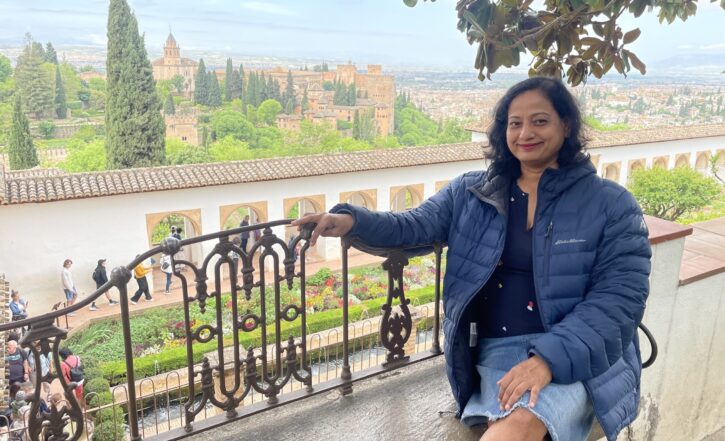
A brief history
Alhambra, sitting high on the mountainside overlooking the ancient city of Granada deserves its status as a UNESCO World heritage Site. Built in the 1200s by King Muhammed Al-Ahmar (founder of the Nasrid Dynasty, the last Muslim dynasty in the Iberian Peninsula), who ruled over the region of Granada for several years before the Christians took back Spain from the Moors.
Since then, the Alhambra Palace has been ruled only by Christian kings. Despite this, the architecture of Alhambra has remained predominantly Islamic, making both the interior and exterior exceptional to look at. This fascinating story makes Alhambra one of Spain’s most visited historical sites.
To fully enjoy Alhambra, it is essential to know the layout and importance of each site.
The Alcazaba
The military fortress of Alcazaba is located on the highest point of the hill and overlooks the city. It was built in the 13th century by Muhammed I. When built, it was a mini citadel with army barracks, watch towers and gardens. Until the 14th century, it housed the palace and residence of Muhammed I (before the Nasrid Palaces were built).
There is also a tower here, which you can climb for great views of the city of Granada.
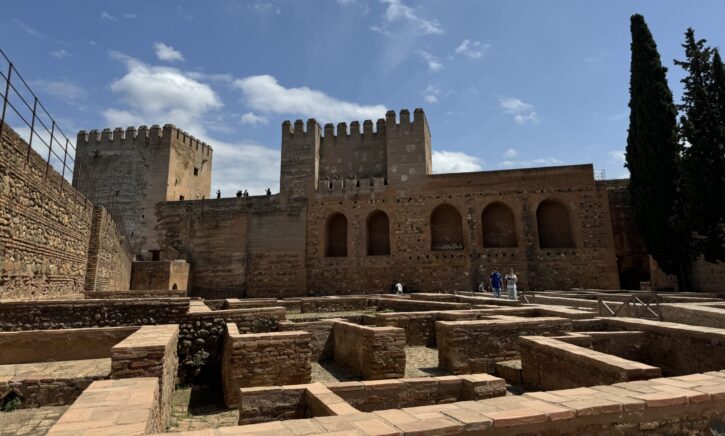
Within Alcazaba, there are a few sites you shouldn’t miss – these include the Jardines de los Adarves (Garden of the Ramparts), a small garden along the ramparts that offer a gorgeous view of the city, Plaza de Armas (Arms Square), the place held homes of several important people including those serving in the army, Torre de la Vela (watch tower) with four floors and the best views of the city and the Torre de Armas (Tower of Arms) with an interesting gateway called the Puerta de las Armas, which is possibly the oldest gate of the Alhambra.
Generalife
This was the summer palace and country estate of the Nasrid rulers. The beautiful gardens of Alhambra are housed in Generalife. The enchanting walkways, fountains, ornamental trees, hedgerows, and giant ancient trees form a part of the landscape. The Generalife was the summer palace. The spaces are interspersed by decorative water structures – from fountains to cascades and pools. These gardens are believed to be one of the oldest Moorish gardens designed to represent paradise.
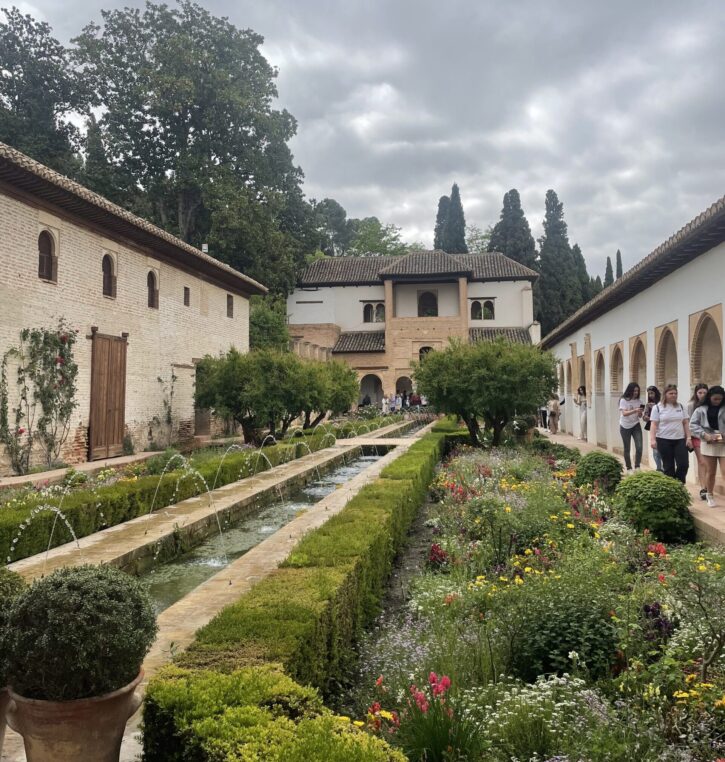

The highlights of Generalife include Patio de la Acequia, a long pool with jets of water and arched porticos on either end and Court of the Sultana’s Cypress Tree, a place full of cypress trees, ponds, stone fountains and Water stairway with four levels of flowing water. At the beginning of Spanish Christian rule in Granada, the Generalife underwent various changes and additions.
Charles V Palace
The palace of Charles V located next to the Nasrid Palaces is a complete contrast to the rest of the site. This palace is from the Christian time of the Royal Alhambra and the difference in architecture is obvious.
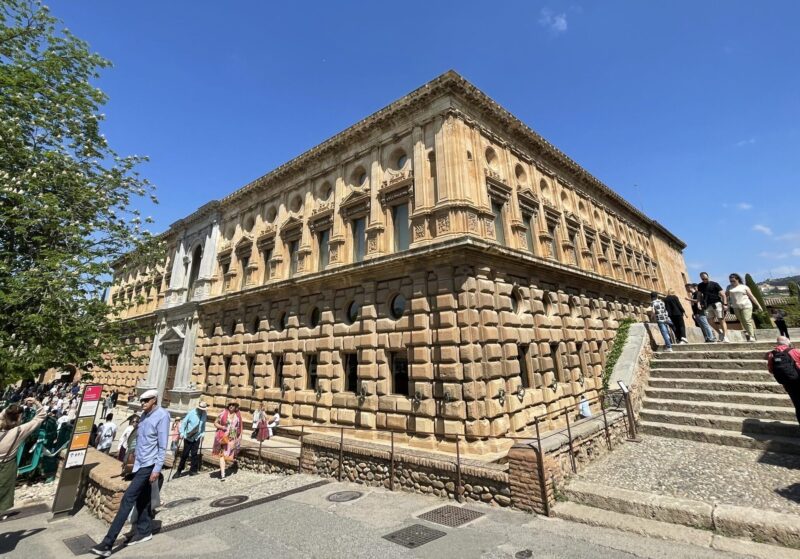
This palace was built in the newer Renaissance style but is extraordinarily beautiful with its expansive circular courtyard, massive columns, and circular ceiling opening.

The Museum of the Alhambra in the Palace of Charles V
The Nasrid Palaces
One of the unmissable parts of my visit to Alhambra was the Nasrid Palaces. It deserves a separate mention altogether. My ticket was for 4 pm – but it was worth the wait. The history of Nasrid Palaces, the primary homes of the Moorish kings is interesting too. To escape the attack from the Castilian kings, Muhammed I moved his base to Sabica hill in the early 1200s. However, only in the 13th century when the Nasrid dynasty reached stability did, he order for separate elegant palaces to be constructed.
Sadly, he did not get to enjoy Nasrid palaces. Subsequent additions were made, which were torn down by the Nasrid emir, Yusuf I – and replaced by grander and more elegant Nasrid palaces. In fact, Yusuf I and his son Muhammed V are credited for the Moorish architecture, Nasrid art, beautiful baths, tilework, and extraordinary Moorish courtyards with stunning fountains seen today.
The Nasrid Palaces became the symbols of the wealth and prosperity of the ruling dynasty. They remained so, even after the palaces were handed over to the Spanish kings by the last Nasrid King – Muhammed XII.
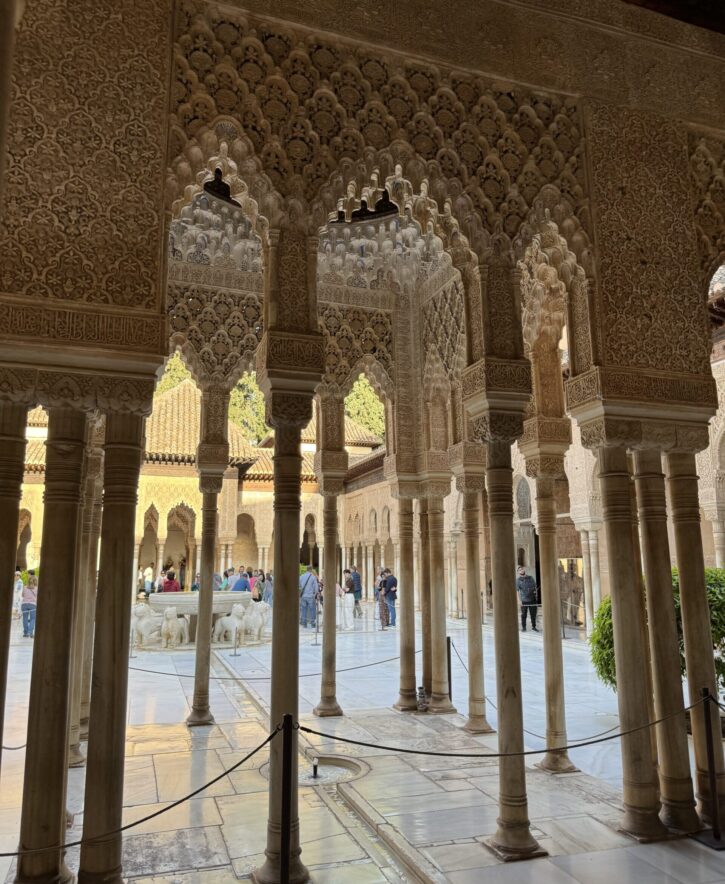

As per my ticket, I was allowed into the Palaces only at 4 pm. Truth be told – it is nearly impossible to go over every detail of the palace in such a short time, but you can, if you try, see it all. There are three independent areas in the Nasrid Palaces – the Mexuar, the Comares Palace (official residence of the King) and the Palace of the Lions (private area of the palace, where the harem was located.
The key highlights of the Nasrid Palaces include the Patio de los Arrayanes, or the Court of the Myrtles with two stunning fountains in a pond, Hall of the Ambassadors which was the meeting room for the King, the Comares Tower, the upper part of which includes winter chambers of the King and has special stained-glass windows that prevent harsh winter light from flooding the interiors, Hall of the Boat, which was restored after a fire damaged it, the Patio del Cuarto Dorado, The patio of the gilded room is a façade created by Muhammed V connecting the Mexuar to the Comares palace.
Click here for detailed post Nasrid Palaces

Visiting Alhambra
Alhambra is mammoth, and it takes hours to walk between the sites. Allow yourself 3-4 hours or more to see the different areas. To visit the Nasrid Palaces, you will be given certain time slots, and you will be allowed entry at the time mentioned in your ticket. You cannot stay longer than three hours here.
- Bring ID (you’ll be asked for it on entry to Alhambra castle).
- Visit in the afternoon. Mornings are great to avoid heat, but it’s usually crowded. The late afternoons are quieter.
- Choose early evening for better light. The harsh light of midday can make taking photos of Alhambra a little harder.
- Visit outside of high season (summer) for fewer crowds.
- Allow for 3-4 hours (or more) to see everything in Alhambra Palace.
- Bring water and sunscreen, especially in the high temperatures of the summer.
- Wear good shoes. The Alhambra Royal Palace is massive, so wear suitable footwear for walking around.
- Drones are prohibited in Alhambra, and selfie-sticks and tripods are restricted in some areas.
- Don’t bring backpacks or suitcases – you’ll be asked to leave them in the locker room at the entrance.
Other useful info
Arriving in Granada
By Air: Granada’s airport, Garcia Lorca, is very small and easy to get around. If you’re staying in or near the city center, consider taking the Alsa bus 245. The driver speaks English, and the 40-ish minute ride is only 3 Euros.
By Bus: Granada’s bus terminal is much larger than the airport, so a little confusing for the first timer. The buses are on the lower level along with the cafes and restrooms. Ticketing and taxis are upstairs. Alsa buses (the national bus line) arrive from all over Spain hourly. you can easily find a cab for the 20 min ride into the city.
By Train: The Granada train station is located close to the center of town, a quick cab or slightly longer bus ride into the center. ***Please note – the high speed rail doesn’t connect to Granada – you’ll need to go to nearby Antequera and connect to a slower, local train into Granada.

